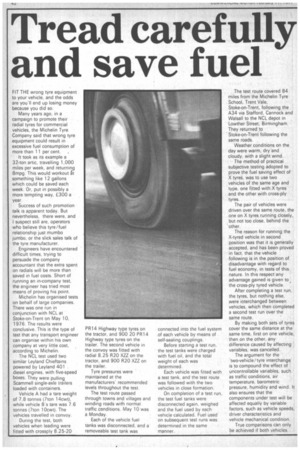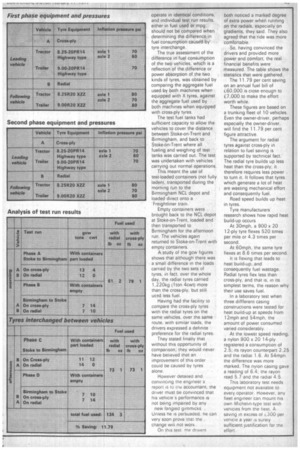Tread carefully and save fuel
Page 44

Page 45

If you've noticed an error in this article please click here to report it so we can fix it.
FIT THE wrong tyre equipment to your vehicle, and the odds are you'll end up losing money because you did so.
Many years ago, in a campaign to promote their radial tyres for commercial vehicles, the Michelin Tyre Company said that wrong tyre equipment could result in excessive fuel consumption of more than 11 per cent. , It took as its example a 32-ton artic, travelling 1,000 miles per week, and returning 8mpg. This would workout St something like 12 gallons which could be saved each week. Or, put in possibly a more tempting way, £300 a year.
Success of such promotion talk is apparent today. But nevertheless, there were, and I suspect still are, operators who believe this tyre/fuel relationship just mumbo jumbo, or the slick sales talk of the tyre manufacturer.
Engineers have encountered difficult times, trying to persuade the company accountant that the extra spent on radials will be more than saved in fuel costs. Short of running an in-company test, the engineer has tried most means of proving his point.
Michelin has organised tests on behalf of large companies. There was one run in conjunction with NCL at Stoke-on-Trent on May 10, 1976. The results were conclusive. This is the type of test that any transport engineer can organise within his own company at very little cost, according to Michelin.
The NCL test used two similar Leyland Chieftains powered by Leyland 401 . diesel engines, with five-speed boxes. They were pulling Scammell single-axle trailers loaded with .containers.
Vehicle A had a tare weight of 7.8-tonnes (7ton 14cwt), while vehicle B's tare was 7.6 tonnes (7ton 11Dcwt). The vehicles travelled in convoy.
During the test, both vehicles when leading were fitted with crosspiy 8.25-20. PR14 Highway type tyres on the tractor, and 900 20 PR14 Highway type tyres on the trailer. The second vehicle in the convoy was fitted with radial 8.25 R20 XZZ on the tractor, and 900 R20 XZZ on the trailer.
Tyre pressures were maintained at the manufacturers' recommended levels throughout the test.
The test route passed through towns and villages and winding roads with normal traffic conditions. May 10 was a Monday.
Each of the vehicle fuel tanks was disconnected, and a rernoveable test tank was connected into the fuel system of each vehicle by means of self-sealing couplings.
Before starting a test run, the test tanks were charged with fuel oil, and the total weight of each was determined.
Each vehicle was fitted with a test tank, and the test route was followed with the two vehicles in close formation.
On completion of a test run, the test fuel tanks were disconnected again, weighed and the fuel used by each -vehicle calculated. Fuel used on subsequent test runs was determined in the same manner. The test route covered 84 miles from the Michelin Tyre School, Trent Vale, Stoke-on-Trent, following the A34 via Stafford, Cannock and Walsall to the NCL depot in Lowther Street, Birmingham.They returned to Stoke-on-Trent following the same roads.
Weather conditions on the day were warm, dry and cloudy, with a slight wind.
The method of practical subjective testing adopted to prove the fuel saving effect of X tyres, was to use two vehicles of the same age and type, one fitted with X tyres and the other with cross-ply tyres.
The pair of vehicles were driven over the same route, the one on X tyres running closely, but not too close, behind the other.
The reason for running the X-tyred vehicle in second position was that it is generally accepted, and has been proved in fact, that the vehicle following is in the position of disadvantage with regard to fuel economy, in tests of this nature. In this respect any advantage gained is given to the cross-ply tyred vehicle.
After completing a test run, the tyres, but nothing else, were interchanged between vehicles, which then completed a second test run over the same route.
By making both sets of tyres cover the same distance at the same time, first on one vehicle, then on the other, any difference caused by affecting variables, was cancelled.
The argument for the 'two-vehicle/tyre interchange' is to compound the effect of uncontrollable variables, such. as traffic conditions, air temperature, barometric pressure, humidity and wind. It also ensures that the components under test will be affected equally by variable factors, such as vehicle speeds, driver characteristics and vehicle mechanical condition.
True comparisons can only be achieved if both vehicles operate in identical conditions, and individual test run results, either in fuel used or mpg, should not be compared when determining the difference in fuel.consumption caused by tyre interchange.
The true assessment of the difference in fuel consumption of the two vehicles, which is a reflection of the difference or power absorption of the two kinds of tyres, was obtained by comparing the aggregate fuel used by both machines when equipped with X tyres, against the aggregate fuel used by both machines when .equipped with cross-ply tyres.
The test fuel tanks had sufficient capacity to allow the vehicles to cover the distance between Stoke-on-Trent and Birmingham, and back to Stoke-on-Trent where all fueling and weighing of test tanks was carried out. The test was undertaken with vehicles carrying out normal operations.
This meant the use of test-loaded containers (not fully laden), transported during the morning run to the Birmingham NCL depot and loaded direct onto a 'Freightliner train.'
Empty containers were brought back to the NCL depot at Stoke-on-Trent, loaded and then transported to Birmingham for the afternoon run. The vehicles again returned to Stoke-on-Trent with empty containers.
A study of me gcw figures shows that although there was a small difference in the loads carried by the two sets of tyres, in fact, over the whole day, the radial tyres carried 1,220kg clton 4cwt) more than the cross-ply, but still uEacl less fuel.
Having had the facility to compare the cross-ply tyres with the radial tyres on the same vehicles, over the same route, with similar loads, the drivers expressed a definite preference for the radial tyres.
Tney stated finally mat without this opportunity of comparison, they would never have believed that an improvement of this order could be caused by tyres alone.
However detailed and convincing me engineer s report is to me accountant, tne driver must be convinced tnat nis venicie's performance is not being impaired by any neW tangled gimmicks Unless he is persuaded, ne can very soon prove mat tne change will not work.
On this test me drivers both noticed a marked degree of extra power when running on the radials, especially on gradients, they said. They also agreed that the ride was more comfortable.
So, having convinced the drivers and provided more, power and comfort, the real financial benefits were measured. The table shows the statistics that were gathered.
The 11,79 per cent saving on an annual fuel bill of £60,000 is close enougn to £7,000 to make the effort worth while.
These figures are based on a trunking fleet of 10 vehicles_ Even the owner-driver, perhaps especially the owner-driver, will find the 11.79 per cent figure attractive.
The argument for radial tyres against cross-ply in relation to fuel saving is supported by technical fact. The radial tyre builds up less heat than the cross-ply; it therefore requires less power . to turn it. It follows that tyres which generate a lot of heat are wasting mechanical effort and consequently fuel.
Road speed builds up heat in tyres.
Tyre manufacturers' research shows how rapid heat build-up occurs At 30mph, a 900 x 20 12-ply tyre flexes 520 times per mile or 4.3 times per second.
At 60mph, the same tyre flexes at 8.6 times per second.
It is flexing that leads to neat build-up, and consequently fuel wastage. Radial tyres flex less than cross-ply, and that is, in its simplest terms, the reason why their use saves fuel.
In a laboratory test when three diffferent casing constructions were tested for heat build-up at speeds from 12mph and 54mph, the amount of power consumed varied considerably.
At the lowest speed reading, a nylon 900 x 20 14-ply registered a consumption of 2.5: its rayon counterpart 2.25 and tne radial 1.6. At 54mpri tile difference was more marked. The nylon casing gave a reading of 6.4; tne rayon read 5.7 and the radial 4.5.
This laboratory test needs equipment not available to every operator. However, any fleet engineer can mount his own Michelin-type test with vehicles from tne fleet. A saving in excess of 300 per vehicle a year is surely sufficient Justification for inc effort.
























































































































